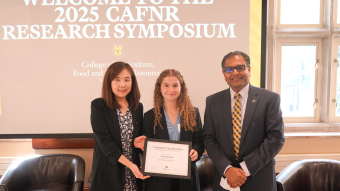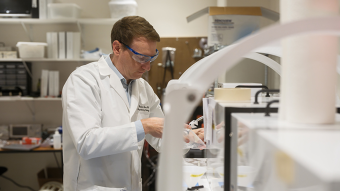Sept. 4, 2024
Contact: Courtney Perrett, 573-882-6217, cperrett@missouri.edu
Video by Mizzou Visual Productions
For centuries, American farmers have strived to produce more crops. In recent years, challenges such as an unpredictable climate and shifts in consumer demands and agricultural policy have ramped up the pressure for farmers to grow even more. Rob Myers, the director of the University of Missouri’s Center of Regenerative Agriculture, has solutions — for Missouri and the rest of the country.
Since opening in 2021, the center has already attracted more than $40 million in resources to support programs implementing cover crops, silvopasture, regenerative grazing and more with the goal of setting Missouri farmers up for a stable and productive future.
Here are five ways Mizzou’s Center for Regenerative Agriculture is stewarding sustainable farming in Missouri and beyond:
1. Conservation for a brighter future.
Raised on a Midwestern farm in a time when farming involved a lot of tillage and dust storms were prolific, Myers knows that protecting soil from erosion is vital. One strategy to alleviate erosion is introducing climate-smart practices, such as cover crops — plants designed to protect and improve soil during a time when other crops are not being grown .
In an effort to implement these protections across Missouri, the center’s work is supported by several large grants, including two new grants totaling $1.5 million from the National Fish and Wildlife Foundation (NFWF). The funding will allow the center to help farmers participate in programs that implement sustainable practices on their land. One of the new grants will be coordinated by Myers on virtual fencing for cover crop grazing. The second will be led by Kelly Wilson, the Center’s associate director, and will help guide women landowners and operators in developing management plans and implementing best practices for conservation through the NFWF Conservation Partners Program.
2. Resilience for cattle and crops.
Making sustainable changes on a farm is a lengthy and expensive process. The Missouri Climate-Resilient Crop and Livestock (CRCL) Project — a five-year initiative of $25 million from the United States Department of Agriculture (the largest federal grant ever received at University of Missouri) — is poised to support the transition for many of Missouri’s producers. The program already has enrolled more than 700 farmers who collectively use climate-smart practices on over 120,000 acres of farmland across the state, and Myers expects that number to double in the next few years.
Funding from the project combined with the expertise from Myers and his team support farmers as they adopt climate-smart practices such as cover crops, sustainable grazing and pollinator habitat — proven regenerative techniques that make their businesses more resilient, ecologically sound and profitable.
“Farmers we visited recently at a farm near St. Louis were enrolled in the CRCL project and said the Center’s expertise in helping them adopt sustainable practices transformed their cropping systems and improved yields,” Myers said. “Their crops were healthier, and farmers were better equipped to deal with weather challenges due to cover crops and regenerative grazing practices.”
3. $10 million in seed money.
Good seed is pivotal in increasing the acreage of cover crops on farmland, Myers said. Supporting this initiative is a $10 million National Institute of Food and Agriculture grant that involves interdisciplinary collaboration among 14 Mizzou faculty members and 24 additional scientists from across the country. Myers and the interdisciplinary research team will develop new varieties of cover crops and educate farmers on which varieties are best suited for different regions of the country, depending on geography, weather conditions and soil type. Myers believes that cover crops are a pivotal step toward safeguarding a farm from extreme weather and building resilience.
4. Growing the economy.
Consumers are becoming increasingly conscious of sustainability, leading major food and agriculture companies to consider regenerative practices such as using cover crops and implementing better grazing methods. Myers pointed to the company Wrangler, which has committed to improving cotton farming practices globally, as an example of a company that is meeting a new market demand for a sustainable product. One of the center’s goals, Myers said, is to keep track of market opportunities related to regenerative agriculture and help producers adjust so that their products remain competitive.
“Many consumers in today’s marketplace are willing to pay a little extra to have food or clothing products that are grown sustainably,” Myers said. “Companies are interested in farmland practices the center is addressing, including promoting conservation buffers and pollinator habitat that have benefits for biodiversity and water quality. Farming practices like cover crops and silvopasture that sequester carbon in the soil are of particular interest to companies seeking to lower their carbon footprint.”
5. Addressing carbon on a large scale.
Companies are trying to balance their carbon output by transitioning to sustainable, regenerative practices that sequester carbon in the soil and reduce greenhouse gas emissions. For Myers and the center, that means helping farmers implement a diverse set of conservation plantings and approaches that can build soil carbon and help make soils more resilient to prolonged droughts or intense rainstorms.
Along with other climate-smart practices, introducing perennial conservation plantings such as pollinator habitat and buffer strips helps reduce carbon emissions as these plants store carbon underground, keeping it out of the atmosphere. This natural habitat also increases the biodiversity of plants on key sections of farmland, which also helps prevent pesticides and fertilizers from been washed off fields during rainstorms.



